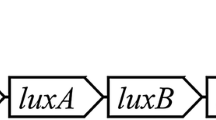Abstract
TheSalmonella typhimurium leu-500 auxotrophic mutant grew when cultivated in minimal medium anaerobically, but not aerobically. This mutant carries an AT → CG mutation in the Pribnow box of the promoter region of the leucine operon and was found to be suppressible by anaerobic conditions. Analysis of the anaerobic gases revealed that hydrogen in the anaerobic gas mixture (85% N2, 10% CO2, 5% H2) is essential for the suppression of theleu-500 mutation. Whenleu-500 mutant cells were incubated in the presence of the hydrogen gas, the synthetic rates for the first and last gene products of theleu-500 operon were similar to those of the wild-type cells. It was concluded that the entire leucine operon was efficiently expressed inleu-500 when the cells were grown under the hydrogen gas-containing anaerobic environment. Thus, theleu-500 promoter mutant is a model system for regulation of gene expression by a specific atmospheric environment, i.e., hydrogen gas found in the anaerobic environment.
Similar content being viewed by others
Literature Cited
Burns RO, Calvo J, Marolin P, Umbarger HE (1966) Expression of the leucine operon. J Bacteriol 91:1570–1576
Cavari BZ, Avi-Dor Y, Grosswicw N (1968) Induction by oxygen of respiration and phosphorylation of anerobically grownEscherichia coli. J Bacteriol 96:751–759
Chamberlin MJ (1974) The security of transcription. Annu Rev Biochem 43:721–775
Droffner ML, Yamamoto N (1983) Anerobic cultures ofSalmonella typhimurium do not exhibit inducible proteolytic function ofrecA gene andrecBC function. J Bacteriol 156:962–965
Dubnau E, Margolin P (1972) Suppression of promoter mutations by the pleiotrophicsupX mutations. Mol Gen Genet 117:91–112
Gemmill RM, Tripp M, Friedman SB, Calvo JM (1983) Transcriptions initiation sites of the leucine operon ofSalmonella typhimurium andEscherichia coli. J Mol Biol 170:39–59
Gemill RM, Tripp M, Friedman SB, Calvo JM (1984) Promoter mutation causing metabolite repression ofSalmonella typhimurium leucine operon. J Bacteriol 158:948–953
Gilbert W (1976) Starting and stopping sequences for the RNA polymerase. In: Losick R, Chamberlin MJ (eds). RNA polymerase. Cold Spring Harbor, NY: Cold Spring Harbor Laboratory, pp 183–205
Gray CT, Wimpenny JWT, Hughes DE, Mossman MR (1966) Regulation of metabolism in facultative bacteria I. Structural and functional changes inEscherichia coli associated with shifts between the aerobic and anaerobic states. Biochim Biophys Acta 117:22–32
Gray CT, Wimpenny JWT, Mossman MR (1966) Regulation of metabolism in facultative bacteria II. Effects of anaerobiosis, aerobiosis and nutrition of the formation of Krebs cycle enzymes. Biochim Biophys Acta 117:33–41
Gross SR, Burns RO, Umbarger HE (1963) The biosynthesis of leucine. II. The enzymatic isomerization of α-carboxy-α-hydroxy-α-isocaproate and α-hydroxy-α carboxyisocaproate. Biochemistry 2:1046–1052
Haddock BA, Jones CW (1977) Bacterial respiration. Bacteriol Rev 48:47–99
Kelly DP, Watson S, Zaverzin GA (1989) Aerobic chemolithotrophic bacteria and associated organisms. In: Bergey's manual of systematic bacteriology. Baltimore: Williams and Wilkins, pp 1807–1889
Margolin P (1963) Genetic fine structure of the leucine operon inSalmonella typhimurium. Genetics 48:441–457
Reznikoff WR (1976) Formation of the RNA polymerase-lacpromoter open complex. In: Losick R, Chamberlin MJ (eds) RNA Polymerase. Cold Spring Harbor, NY: Cold Spring Harbor Laboratory, pp 139–182
Tracksis M, Golub EI, Zebel DJ, Depew RE (1981)Escherichia coli andSalmonella typhimurium supX genes specify deoxyribonucleic acid topoisomerase I. J Bacteriol 147:679–681
Waring MJ (1965) Complex formation between ethidium bromide and nucleic acids. J Mol Biol 13:269–282
Yamamoto N, Droffner ML (1985) Mechanisms determining aerobic or anaerobic growth in the facultative anaerobeSalmonella typhimurium. Proc. Natl Acad Sci USA 82:2077–2081
Yamamoto N, Droffner ML (1988) Anaerobic expression ofgyrA gene as demonstrated byβ-galactosidase activity ingyrA::Mudlac fusion derivatives ofEscherichia coli. FEMS Microbiol Lett 56:209–214
Yamamoto N, Droffner ML, Yamamoto S (1987) Conditional mutations ofSalmonella typhimurium that are suppressed by anaerobic or aerobic environments. FEMS Microbiol Lett 42:249–252
Zobell CL, Johnson FH (1948) The influence of hydrostatic pressure on the growth and viability of terrestrial and marine bacteria. J Bacteriol 57:179–188
Zuo ET, Tanious FA, Wilson WD, Zon G, Tan G, Wartel GM (1990) Effect of base-pair sequence on the conformations and thermally induced transitions on oligodeoxyribonucleotides containing only AT base pairs. Biochemistry 29:443–453
Author information
Authors and Affiliations
Rights and permissions
About this article
Cite this article
Droffner, M.L., Yamamoto, N. The leucine operon carrying theleu-500 promoter mutation is expressed under anaerobic conditions. Current Microbiology 22, 293–297 (1991). https://doi.org/10.1007/BF02091957
Issue Date:
DOI: https://doi.org/10.1007/BF02091957



